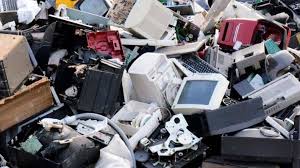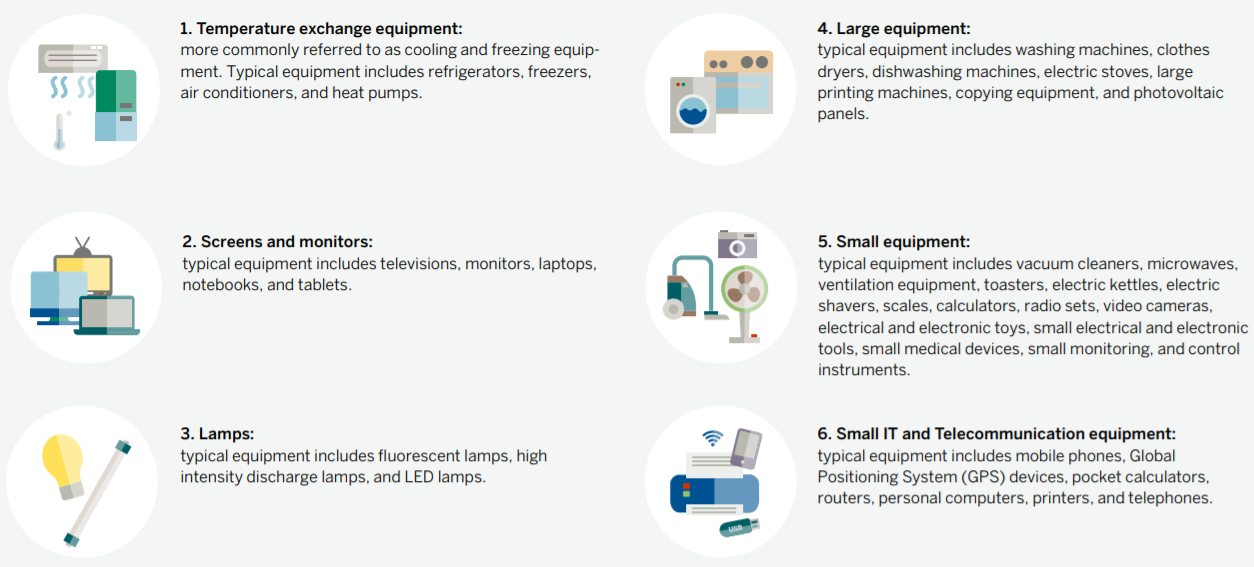INDIA'S E-WASTE PROBLEM
2020 JUL 7
Mains >
Environment & Ecology > Pollution > E waste

IN NEWS:
- As per the UN’s Global E-waste Monitor 2020, India is the third largest electronic waste generator in the world after China and the USA.
WHAT IS E-WASTE:
- The term "e-waste" is an abbreviation of "electronic and electrical waste".
- E-waste is any electrical or electronic equipment that has been discarded without the intent of re-use.
- E-waste is categorized as hazardous waste due to the presence of toxic materials such as mercury, lead and brominated flame retardants.
Types:

ABOUT THE REPORT:
- The Global E-waste Monitor 2020 is a collaborative product of the Global E-waste Statistics Partnership (GESP), formed by UN University (UNU), the International Telecommunication Union (ITU), and the International Solid Waste Association (ISWA), in close collaboration with the UN Environment Programme (UNEP).
- Key Findings:
- In 2019, the world generated 53.6 Mt of e-waste, an average of 7.3 kg per capita. The formal documented collection and recycling was 9.3 Mt, which is 17.4% compared to e-waste generated.

-
- The global generation of e-waste grew by 9.2 Mt since 2014 and is projected to grow to 74.7 Mt by 2030 – almost doubling in only 16 years.
- Asia generated the highest quantity of e-waste in 2019 at 24.9 Mt, followed by the Americas and Europe.

THREATS POSED BY E-WASTE:
- On health: As a result of poor waste management, chlorinated and brominated compounds accumulates in fishes and other organisms and undergo bioaccumulation, which result in high values in top-level carnivores including humans. PCB are also absorbable via skin and inhaled, causing neurotoxicity, liver damage, tumors, immunosuppression and behavioral changes.
- On soil and water: The most common method of disposing e-wastes is through landfills. The dangerous metals and toxic chemicals that electronic waste contains do not organically break down and can, over time, seep into the environment around landfills, polluting the soil as well as the groundwater.
- On air: Gases released from the burning of e-wastes such as circuit boards and brominated fire retardants release highly volatile carcinogenic compounds as well as ozone depleting gases. They have a profound impact on global warming and ozone depletion.
BASEL CONVENTION:
- ‘The Basel Convention on the Control of Transboundary Movements of Hazardous Wastes and Their Disposal’ is a multilateral treaty aimed at suppressing environmentally and socially detrimental hazardous waste trading patterns.
- The Convention affirms that in order to protect human health and the environment, hazardous waste should not be traded freely like ordinary commercial goods, and thus it establishes a written notification and approval process for all cross-border movements of hazardous wastes.
- The Basel Convention started to address e-waste issues since 2002. The Mobile Phone Partnership Initiative (MPPI) and the Nairobi Declaration on the Environmentally Sound Management of Electrical and Electronic Waste were adopted in this regard.
INDIA AND E-WASTE MANAGEMENT:
- India is the third largest producer of e-waste, generating about 2.4 kg of e-waste per capita.
- India is the only country in Southern Asia with e-waste legislation. There are 312 authorized recyclers in India, with the capacity for treating approximately 800 KT annually.
MEASURES TAKEN SO FAR:
- E-Waste (Management) Rules, 2016 was enacted to encourage recycling and regulate e-waste management in the country.
- Applicability: It covers Producers, Consumers, Collection Centres, Dismantlers & Recyclers, Manufacturers, Dealers, Refurbishers, and Producer Responsibility Organisations (PROs). But Micro and Small Industries are exempted from its ambit.
- Coverage: The rules are applicable to several equipments/products, components, consumables, spares and parts of EEE. Compact Fluorescent Lamp (CFL) and other mercury-containing lamp are also covered under the rules.
- Collection centers: The rules call for establishing collection centres, collection point, take back system, etc. for collection of e-waste by producers under Extended Producer Responsibility (EPR).
-
- Deposit Refund Scheme has been introduced as an additional economic instrument wherein the producer charges an additional amount as a deposit at the time of sale of the electrical and electronic equipment and returns it to the consumer along with interest when the end-of-life electrical and electronic equipment is returned.
- Urban Local Bodies are assigned the duty to collect and channelize orphan products to authorized dismantler or recycler.
- Hazardous and other wastes (Management & Transboundary Movement) Rules 2016:
- It seeks to ensure management, transboundary movement, resource recovery and disposal of hazardous waste in an environmentally sustainable manner.
- Under the rules, waste electrical and electronic assemblies scrap are prohibited for import.
- Swachh Digital Bharat: seeks to raise awareness among the public regarding the recycling of e-wastes by unorganised sector and to educate them about alternative methods of disposing of their e-waste. The general public is encouraged to participate in the programme, by giving their e-waste to authorised recyclers only.
- Greene: The programme aims to create effective awareness in various levels of society to reduce the adverse impact on environment and health arising out of the polluting technologies used in recycling e-waste in the unorganized sector.
SIGNIFICANCE OF E-WASTE:
- Economic significance: E-waste is composed of up to 69 valuable recoverable minerals such as Gold, Platinum, Cobalt, Palladium, Germanium, Bismuth and Zirconium, which are critical for the manufacture of electronic gadgets. Recycled metals are also 2 to 10 times more energy-efficient than metals smelted from virgin ore.
- Geopolitical significance: Elements used in e-wastes, such as rare earth metals, are a key component for the modern-day tech-driven economy. Currently, China enjoys a distinct advantage on rare earth minerals on account of both primary deposits and mining from waste. In the past, it has used this as a leverage against Japan, which is deficient of such metals. Hence, having proper e waste management systems are vital for India’s national interests.
- Success of SDGs: E-waste management closely relates to many SDGs, such as SDG 8 on decent work and economic growth, SDG 3 on good health and well-being, SDG 6 on clean waste and sanitation, and SDG 14 on life below water.
CHALLENGES TO E-WASTE MANAGEMENT IN INDIA:
- Poor management: Formal recycling capacity remains underutilized, as the large majority of the waste is still handled by the informal sector. Only 17.4% (9.3 Mt) of the total e-waste was collected and recycled globally. It means are dumped or burned in e-waste last year.
- Volume of e-waste generated: India’s electronics industry is one of the world’s fastest growing industries and plays a huge role in the domestic generation of e-waste. With changing consumer behavior and rapid economic growth, it is estimated that India will generate 5.2 million tonnes of e-waste by the end of 2020.
- Infrastructure deficit: The number of recycling and collection facilities in India are dismal compared to the amount of e-waste being generated in India. Most of the facilities are heavily reliant on unskilled manual labour and uses crude extraction methods.
- Ineffective enforcement: There are several inadequacies in the regulatory mechanism. The current framework continues to ignore the informal sector. Also, there is no independent mechanism to verify the implementation of Extended Producer Responsibility (EPR). The law mandates random inspections by the Central Pollution Control Board (CPCB) and state PCBs, but they are rarely carried out.
- Social impact: About 95% of India’s e-waste is recycled in the informal sector, dominantly by women and child labourers. The poor management of hazardous e-waste is identified as one of the key reasons for increase in miscarriages, still births and poor infant health among the people working in this sector.
- Lack of awareness: The people handling the waste are largely illiterate and unaware on how to manage e-wastes. On the consumer side, people are unaware of how to handle e wastes and the rules that regulate the disposal of e wastes. They continue to sell their e-waste to the informal sector, which end up in unscientific handling and disposal.
WAY FORWARD:
- Planned approach: Structured management of electronic waste (e-waste) in India is nascent. Since India is highly deficient in precious mineral, there is need for a well-designed, robust and regulated e-waste recovery regime which would generate jobs as well as wealth.
- Circular economy: A circular electronics system - one in which resources are not extracted, used and wasted, but re-used in countless ways- creates a sustainable system and improves cost effectiveness of the industry.
- Integration of informal sector: Active participation of informal sector into overall system is crucial for the success of any e-waste management initiative. One way of attaining this is by developing a direct linkage between informal workers and the producer companies.
- Industry status: In view of the strategic nature of this waste on account of inherent material availability, there is a strong need for recognising recycling as an industry and creating conditions for it to become viable and sustainable.
- Invest in technology: Government should encourage investment in technology that are cutting edge at the same time creates livelihood opportunity for the people. This can be achieved by encouraging establishment of proper collection and logistics infrastructure through entrepreneurship and PPPs.
- Effective enforcement: Though the rules mandate it, majority of brands operating in India do not have a tangible responsibility to handle waste that is generated by their goods at end of life stage. To avoid this, the competence of agencies such as the CPCB and state pollution control boards must be raised.
- Awareness generation: Increasing information campaigns, capacity building, and awareness is critical to promote environment friendly e-waste management programmes.
|
CASE STUDY: NORWAY’S E WASTE TAKE BACK SYSTEM
Like the rules in India, management of e-waste in Norway is also a producer responsibility. However, the EPR implementation in Norway mandates the domestic producers and importers to finance the e-waste collection and treatment systems.
Producers/importers of e-waste in Norway are obliged to be members of a take-back company and have to pay a fee for their membership to the take-back companies. This is how it provides the funding for collection and treatment of the waste. They also need to ensure that they collect all e-waste from their market share which is determined by how much of electronics is put into the market by their members.
The take back companies report back to Waste Electrical and Electronic Equipment (WEEE) register and also finance WEEE register, which are managed by the government.
|
PRACTICE QUESTION:
Q. Despite having legislations, e-waste continues to emerge as a major problem in India. What are the reasons? How can India successfully tackle the issue of e-wastes?



